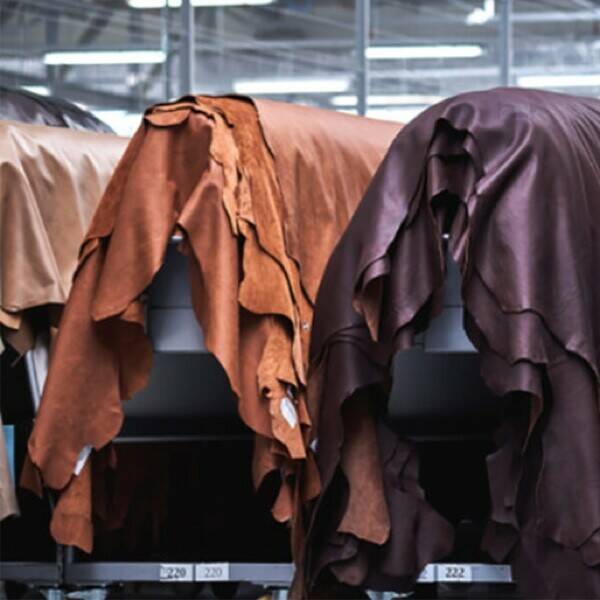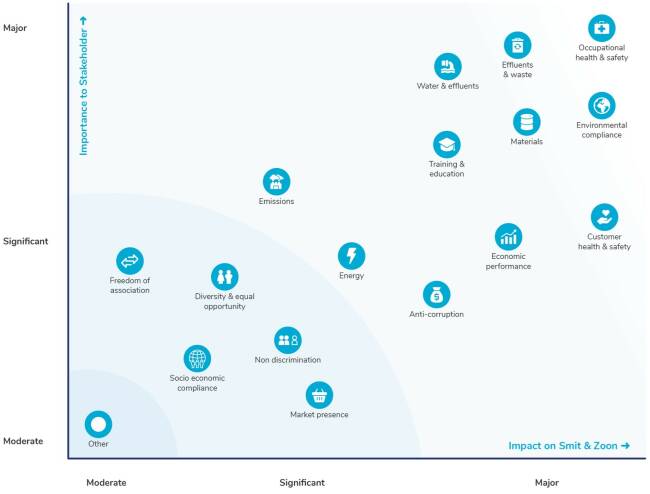Leather is produced globally, in countries with a wide variety of economic and societal circumstances. The leather industry has the potential to employ large amounts of people and thus increase prosperity for nations and all the people involved. We support this through the introduction of innovative technologies & processes that will provide decent work conditions and a good social environment. Training and education to work safely with chemicals is an important part of this development.
















The Materiality of our Operation
The identification of economic, environmental, and social impact takes place through continuous dialogue with key stakeholders in the leather supply chain, active participation in industry organizations, and cooperation in important value chain initiatives. Together, it is the fundament of our Materiality Matrix. The material topics are translated into operational and strategic initiatives via the regular management processes with an intense engagement from the Management Board and the Supervisory Council.
Making the leather value chain socially and environmentally sustainable is our company’s main focus. In this report, we use the UN SDGs as the pillars for our challenges and progress. In the infographic on this page, the impact a topic has on us (horizontal axis) and the concerns our stakeholders have about it (vertical axis) are shown. The topics at the top right are particularly important, both to us and to our stakeholders. Throughout this report, we will display the symbols of the relevant materiality topics.
We believe that positive impact can only be created through collaborations. Therefore we support the leading leather industry organizations to speed the process of creating a socially and environmentally sustainable leather value chain. We are open to collaborations in which we can share our knowledge, expertise, technology, and financial resources.


Climate change is affecting every country on every continent. It is disrupting national economies and effecting lives. Weather patterns are changing, sea levels are rising, and weather events are becoming more extreme. This is why we will keep on focussing on reducing the greenhouse gas emissions in our own premises, positively influence these in our supply chain and off-set our footprint.




Circularity is the principle that drives our Research & Development and our procurement practices. This helps us to create a product portfolio that is mainly built from renewable resources and will support creating a responsible end of life for leather. Our products are developed to have the least possible emissions to minimize the adverse impacts on human health and the environment.


The leather industry is consuming and emitting large amounts of water, that’s why we encourage and support leather manufacturers to improve water quality. This goal can be reached by reducing pollution, minimizing the release of hazardous chemicals, increasing water recycling, safe reuse of water, and reduction of water consumption.



We have identified five UN SDGs as the heart of our company’s strategy. Throughout this report, we will display the UN SDG symbols that connect to the specific topic.
Five UN SDG goals
We keep the United Nations’ 17 Sustainable Development Goals (UN SDG’s) and the universal declaration of human rights close to our business decisions, and we have voluntarily joined the standards and principles of societal institutes like the International Labor Organization (ILO), ZDHC, LWG, SLF, LIA, TEGEWA, MVO Nederland, Ecovadis (Royal Smit & Zoon is GOLD rated), and ISO. We are respectful of international laws and regulations, specific client requirements, the Ethical Trading Initiative base code, the Declaration on Fundamental Principles and Rights of Work and use the GRI Standards as the reporting guideline whenever we can. We strongly believe this is the only way to create a business that is successful for the company and its shareholders, for the industry, for our employees, for our customers, and for society. In fact, this is the way we want to express Environment, Social and Governance, which is described in our updated ESG Policy.
All the elements that add up to our ESG report can be aggregated and condensed into this one motto: Creating Sustainable Leather Together. In everything we do, in our R&D, in our production facilities, in our relations within and outside the industry, in our educational programs, and in the initiatives we support, we feel responsible for the future of leather.
ESG Landscape


The Materiality of our Operation
The identification of economic, environmental, and social impact takes place through continuous dialogue with key stakeholders in the leather supply chain, active participation in industry organizations, and cooperation in important value chain initiatives. Together, it is the fundament of our Materiality Matrix. The material topics are translated into operational and strategic initiatives via the regular management processes with an intense engagement from the Management Board and the Supervisory Council.
Making the leather value chain socially and environmentally sustainable is our company’s main focus. In this report, we use the UN SDGs as the pillars for our challenges and progress. In the infographic on this page, the impact a topic has on us (horizontal axis) and the concerns our stakeholders have about it (vertical axis) are shown. The topics at the top right are particularly important, both to us and to our stakeholders. Throughout this report, we will display the symbols of the relevant materiality topics.
We believe that positive impact can only be created through collaborations. Therefore we support the leading leather industry organizations to speed the process of creating a socially and environmentally sustainable leather value chain. We are open to collaborations in which we can share our knowledge, expertise, technology, and financial resources.


Climate change is affecting every country on every continent. It is disrupting national economies and effecting lives. Weather patterns are changing, sea levels are rising, and weather events are becoming more extreme. This is why we will keep on focussing on reducing the greenhouse gas emissions in our own premises, positively influence these in our supply chain and off-set our footprint.



Leather is produced globally, in countries with a wide variety of economic and societal circumstances. The leather industry has the potential to employ large amounts of people and thus increase prosperity for nations and all the people involved. We support this through the introduction of innovative technologies & processes that will provide decent work conditions and a good social environment. Training and education to work safely with chemicals is an important part of this development.









The leather industry is consuming and emitting large amounts of water, that’s why we encourage and support leather manufacturers to improve water quality. This goal can be reached by reducing pollution, minimizing the release of hazardous chemicals, increasing water recycling, safe reuse of water, and reduction of water consumption.



Circularity is the principle that drives our Research & Development and our procurement practices. This helps us to create a product portfolio that is mainly built from renewable resources and will support creating a responsible end of life for leather. Our products are developed to have the least possible emissions to minimize the adverse impacts on human health and the environment.


We have identified five UN SDGs as the heart of our company’s strategy. Throughout this report, we will display the UN SDG symbols that connect to the specific topic.
Five UN SDG goals
We keep the United Nations’ 17 Sustainable Development Goals (UN SDG’s) and the universal declaration of human rights close to our business decisions, and we have voluntarily joined the standards and principles of societal institutes like the International Labor Organization (ILO), ZDHC, LWG, SLF, LIA, TEGEWA, MVO Nederland, Ecovadis (Royal Smit & Zoon is GOLD rated), and ISO. We are respectful of international laws and regulations, specific client requirements, the Ethical Trading Initiative base code, the Declaration on Fundamental Principles and Rights of Work and use the GRI Standards as the reporting guideline whenever we can. We strongly believe this is the only way to create a business that is successful for the company and its shareholders, for the industry, for our employees, for our customers, and for society. In fact, this is the way we want to express Environment, Social and Governance, which is described in our updated ESG Policy.

All the elements that add up to our ESG report can be aggregated and condensed into this one motto: Creating Sustainable Leather Together. In everything we do, in our R&D, in our production facilities, in our relations within and outside the industry, in our educational programs, and in the initiatives we support, we feel responsible for the future of leather.

